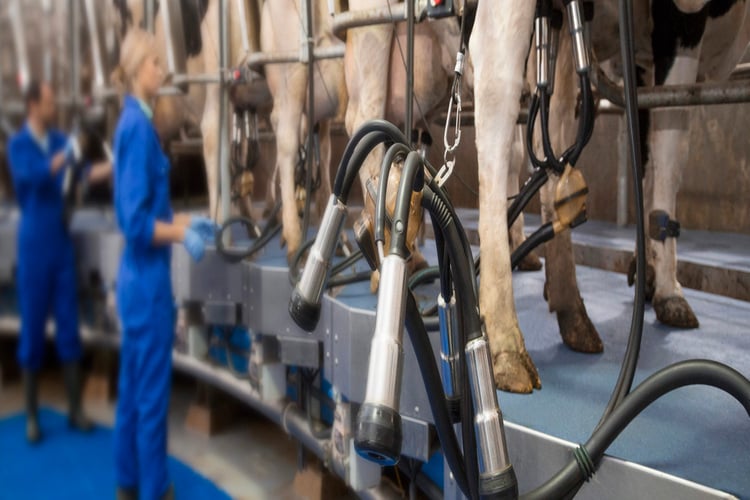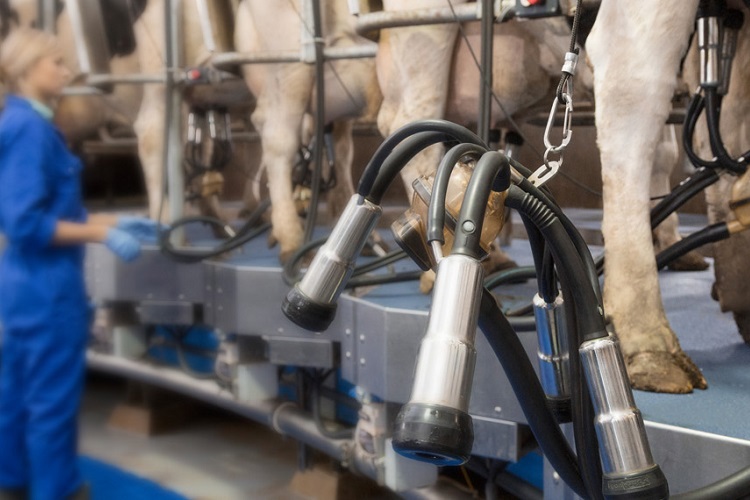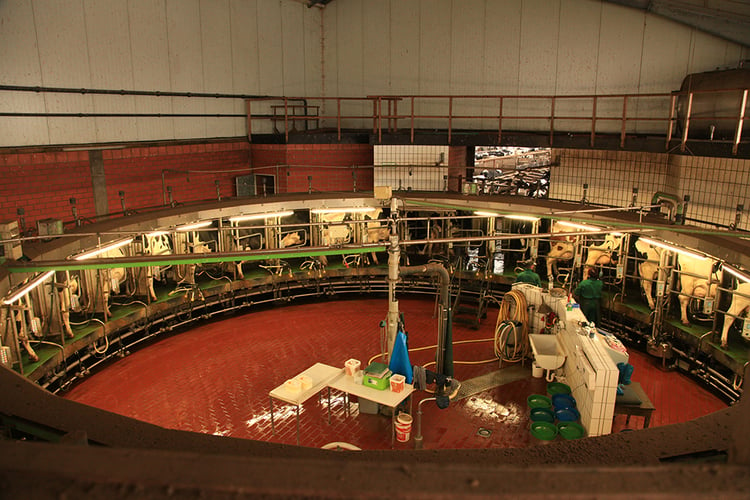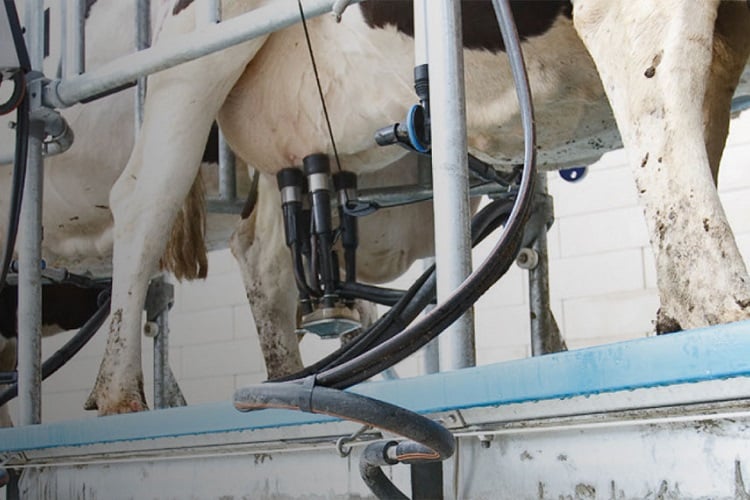- LifeStart
- First lactation
Key takeaways from the research:
- Holstein dairy calves in the Kempenshof LifeStart trial are included immediately after they are born and are followed during their entire productive life
- A LifeStart calf feeding schedule resulted in an increase of pre-weaning growth of 155 g/day
- This difference in pre-weaning growth of calves resulted in the production of 400 litres of additional fat and protein corrected milk production during the first lactation
- The production of extra milk found in our study is likely to result from a difference in energy partitioning.

Elevated levels of pre-weaning nutrition increase first lactation fat and protein corrected milk production
Many researchers have shown the positive effects of elevated levels of pre-weaning nutrition in dairy calves on performance during the first lactation[1,2,3,4,5,6,7,8,9,10,11,12,13]. In many of these trials, only a certain period in the life of a dairy calf or cow was studied. The Kempenshof research programme follows two groups of calves during their entire productive life. It started in 2014 and is still continuing today. Results of the first lactation are presented in this article.
Material and methods
Two groups of 43 Holstein dairy calves were included in the study. Both groups were blocked by colostrum, parity and season after pairs of calves were fed the same amounts of cow colostrum from the same dam. From day 4 onwards, all calves had ad libitum access to water, calf starter feed and straw. Calves were weaned at 56 days of age and moved to group housing from day 70 onwards. The group following the LifeStart calf rearing programme was fed 8 litres of calf milk replacer per day whereas the controls were fed 4 litres per day. Both groups were fed at a concentration of 150 g/l.
Calves in the LifeStart calf rearing programme had a significantly higher body weight from day 7 onwards. The difference in ADG was 155 g/d at weaning and 123 g/day at day 70.
The LifeStart calf feeding schedule resulted in an average increase in production of fat corrected milk in the first lactation of 400 litres (See figure 1 and table 1). Significant differences in both the amount of fat and protein correct milk and the kilograms of fat produced per day were found (see table 1).
Figure 1: Fat and protein corrected milk yield in the first lactation in kg/day in Holstein dairy heifers fed according to a LifeStart feeding schedule compared to heifers fed a restricted feeding schedule.

First lactation |
LifeStart |
Conventional |
p-value |
| Dry-matter intake, kg/d | 19.7 | 19.0 | 0.01 |
| Milk production (FPCM), kg/d | 30.8 | 29.9 | 0.01 |
| Fat, g/d | 1296 | 1213 | |
| Protein, g/d | 995 | 996 | 0.95 |
| Lactose, g/d | 1363 | 1368 | 0.86 |
| Bodyweight, kg | 585 | 593 | 0.44 |
| Body condition score, 1-5 scale | 3.21 | 3.30 |
Table 1: milk production parameters in the first lactation in Holstein dairy heifers raised with a LifeStart feeding schedule compared to dairy cows raised with a restricted feeding schedule.
Body Condition Score throughout the entire lactation was lower in the LifeStart cows as compared to the controls (see table 1). Feed intake during the first lactation was however higher in the LifeStart group (see table 1).
Discussion and conclusion
The Holstein dairy calves in the LifeStart calf rearing programme had an increase in pre-weaning average daily gain of 155 gram/day. Other authors found increases in pre-weaning ADG ranging from 70 to 355 gram/day in calves fed elevated levels of liquid feeding prior to weaning[1,2,3,4,5,6,7,8,9,10,11]. As a result of this increase in ADG, milk production in the first lactation increased significantly. This finding is in line with those of other authors that studied the effect of elevated levels of pre-weaning nutrition on future milk production of dairy heifers[1,2,3,4,5,6,7,8,9,10,11]. With the exception of 1 study by Morisson et al[3], in which no effect on milk production was found, elevated planes of nutrition resulted in additional milk production during the first lactation ranging from 342 to 1,332 kg. Feed intake and Body Condition Score from animals in the LifeStart trial suggest that the increase in milk production found in our study is likely to result from a difference in energy partitioning.
References
[1] Shamay, A., D. Werner, U. Moallem, H. Barash, and I. Bruckental. 2005. Effect of nursing management and skeletal size at weaning on puberty, skeletal growth rate, and milk production during first lactation of dairy heifers. J. Dairy Sci. 88:1460–1469.
[2] Faber, S. N., N. E. Faber, T. C. McCauley, and R. L. Ax. 2005. Case study: Effects of colostrum ingestion on lactational performance. Prof. Anim. Sci. 21:420–425.
[3] Morrison, S. J., H. C. F. Wicks, R. J. Fallon, J. Twigge, L. E. R. Dawson, A. R. G. Wylie, and A. F. Carson. 2009. Effects of feeding level and protein content of milk replacer on the performance of dairy herd replacements. Animal 3:1570–1579.
[4] Davis Rincker LE, VandeHaar MJ, Wolf CA, Liesman JS, Chapin LT and Weber Nielsen MS, Effect of intensified feeding of heifer calves on growth, pubertal age, calving age, milk yield, and economics. J. Dairy Sci 94:3554-3567 (2011).
[5] Moallem, U., D. Werner, H. Lehrer, M. Zachut, L. Livshitz, S. Yakoby, and A. Shamay. 2010. Long-term effects of ad libitum whole milk prior to weaning and prepubertal protein supplementation on skeletal growth rate and first-lactation milk production. J. Dairy Sci. 93:2639–2650.
[6] Raeth-Knight, M., H. Chester-Jones, S. Hayes, J. Linn, R. Larson, D. Ziegler, B. Ziegler, and N. Broadwater. 2009. Impact of conventional or intensive milk replacer programs on Holstein heifer performance through six months of age and during first lactation. J. Dairy Sci. 92:799–809.
[7] Drackley, J. K., B. C. Pollard, H. M. Dann, and J. A. Stamey. 2007. First-lactation milk production for cows fed control or intensified milk replacer programs as calves. J. Dairy Sci. 90(Suppl. 1):614 (Abstr.).
[8] Terré, M., C. Tejero, and A. Bach. 2009. Long-term effects on heifer performance of an enhanced growth feeding programme applied during the pre-weaning period. J. Dairy Res. 76:331–339.
[9] Soberon F, Raffrenato E, Everett RW and Van Amburgh ME. 2012. Preweaning milk replacer intake and effects on long-term productivity of dairy calves. J. Dairy Sci. 95:783-793.
[10] Bolt, A. 2019, Meta-analysis to calculate the effect of rearing intensity on functionality of dairy cows, Research paper Mecklenburg Vorpommern Landesforschungsanstalt für Landwirtschaft und Fischerei.
[11] Soberon, F and M. E. Van Amburgh, 2013, The effect of nutrient intake from milk or milk replacer of preweaned dairy calves on lactation milk yield as adults: A Meta-analysis of current data, J. Anim. Sci. 91:706-712.



